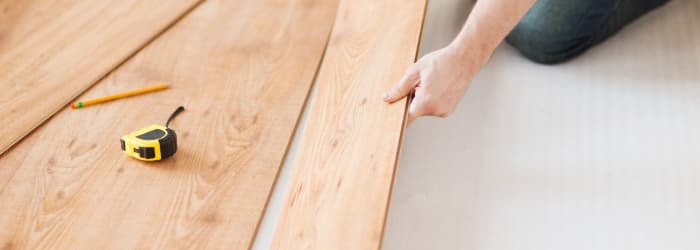Are there other types of flooring that can give you the look you want at a more affordable price point? Yes - laminate flooring products, also called floating flooring. It's now so popular that it accounted for $1.08 billion of the U.S. flooring market in 2021.
This cost-effective alternative to hardwoods has come on in leaps and bounds in recent years and has earned itself a strong reputation. Let's explore what it is, what the advantages are, and some of the drawbacks you should also think about.
What is Laminate?
Laminate flooring is a hardwearing floor covering that is designed to mimic natural wood or stone. It is comprised of separate layers, namely:
- Base layer of high-strength hardboard
- Decorative finish - usually a high-resolution photograph of wood or stone
- Clear, protective final layer
The edges are machined to give them an edge that allows them to be clicked together. It's called floating flooring because it is not nailed down. Instead, it sits atop a layer of underlayment, which makes the floor comfortable to walk on and has insulating properties.
Laminate floors come in many different styles and finishes, meaning that there's bound to be a look that suits your home. Additionally, there are types of appeal to different ages, including ones that have a matte finish, making them safer for kids and seniors.
The Advantages of Laminate Flooring
As mentioned, laminate flooring is usually considerably cheaper than hardwood flooring. According to Yahoo! Finance, the average cost of laying laminate floors runs $6-$14 per square foot, whereas hardwood floors are virtually double that.
Of course, you can lay laminate flooring yourself, but if you're looking for a professional result, it pays to get it installed by people who do it day in and day out.
Easy to Clean
Laminate floors are some of the easiest types of flooring to clean. They do not require expensive cleaning products, and you'll never have to wax or reseal them. All you need to do is run the vacuum over the floor or a soft broom and finish with a dry mop.
If you get spills, a quick wipe with a slightly damp mop is all you need. What you need to avoid is wetting your laminate flooring.
If you use a wringing wet mop, the water can seep down into the unprotected hardboard layer and cause it to swell. However, if you stick to the method above, you won't run into any issues.
Even if spills dry onto the laminate, they're usually easy to clean off. The top clear coat is extremely durable and may even be scratch resistant. All of these factors make it a dream to keep clean.
Endless Variety
The photographic layer on laminate flooring can perfectly match a massive range of flooring types. This gives you a lot of options. So if you want to have a stone effect floor in the kitchen but hardwoods in the hall, you can achieve both looks with floating flooring.
Sure, you will never get the same variety that you get in natural wood. Most companies produce five to ten variations in pattern in a single pack, with some less expensive brands only producing around three. However, with careful placement during installation, you can still create a distinctive appearance.
Great for Allergy Sufferers
Carpet may still be the most popular flooring in America, but it's not a great choice if you have allergy sufferers in the family. Hard floor options are best, and laminate is particularly so. It's so easy to keep clean that it can help you keep levels of dust mites and dander at bay with ease.
The only consideration is formaldehyde, which is a problem for some asthma sufferers. So check out the Material Safety Data Sheet (MSDS) before you buy, and you'll be able to choose new flooring that doesn't use it. Also, look out for healthy home certified flooring that meets strict U.S. guidelines.
The Disadvantages of Laminate Flooring
No product is perfect, and laminate flooring certainly doesn't have the same appeal as hardwoods when it's time to sell your home. In most instances, they will not add anything to the resale value, but the fact is that they're much more affordable to install in the first place.
Don't Get Them Wet
The top, clear layer of laminate flooring offers some resistance to water. That's why it can cope well with spills. However, the same cannot be said for the hardboard layer below.
Traditionally, that layer was very susceptible to water damage. However, there are now types of laminate available that offer much better protection against water. They won't survive a flood, but they are suitable for use in bathrooms, hallways, and kitchens.
Can't be Refinished
When hardwoods start to look a little worse for wear, you have the option of sanding them back and refinishing them. Sadly, with laminate, that isn't the case. So if it gets scratched, dented, or worn, the only solution is to replace it.
However, many laminate manufacturers now offer long warranties on their products, some even lasting for decades. This shows that with good care, laminate flooring can be a long-term floor replacement solution.
Ready to Shop for Laminate Flooring?
Laminate flooring is an awesome way to achieve the look of hardwoods at a fraction of the cost. They are hard-wearing and look great. With expert installation, you'll be proud to show off your new floors to your friends and family.
At National Floors Direct, we supply a wide range of healthy home certified laminate flooring products. Browse our range and find the right product for your home today!


